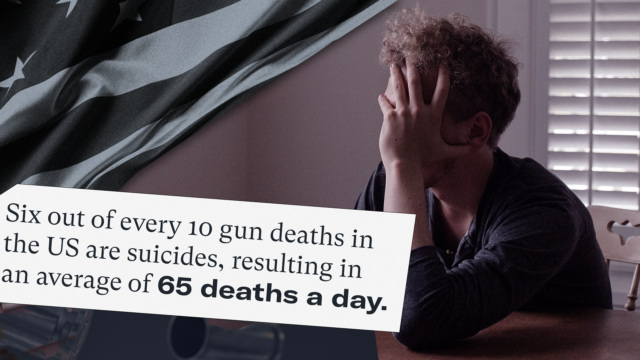Smart Guns and Gun Safety Features
Smart Guns and Gun Safety Features
What does this solve?
A personalized—or “smart”—gun is a firearm that employs authorized-use technology, like the thumb scan or passcode available on many smartphones, to turn stolen guns and guns accessed by children into harmless pieces of steel. If widely implemented, it would be a game-changer for keeping guns out of the hands of children and criminals.
Each year, more than 40,000 Americans die by guns—including more than 3,500 children and teens. There are an estimated 393 million civilian-owned firearms in the U.S., and more than one-third of homes contain at least one gun.
Authorized-use technology, as well as basic safety features like loaded chamber indicators, magazine safety disconnects, and other features designed to prevent a child from operating the gun, should be incorporated into new models of semiautomatic handguns to help prevent firearms from being unintentionally fired.
Despite the fact that guns are inherently dangerous, they are exempt from regulation by the Consumer Product Safety Commission. In addition, the Protection of Lawful Commerce in Arms Act (PLCAA) blocks legal responsibility for gun manufacturers that have failed to innovate and make guns safer.
Which states require new handgun models to have childproofing features?
3 states have adopted this policy
Consumer Safety
Alabama has not adopted this policy
Consumer Safety
Alaska has not adopted this policy
Consumer Safety
Arizona has not adopted this policy
Consumer Safety
Arkansas has not adopted this policy
Consumer Safety
California has adopted this policy
Consumer Safety
Colorado has not adopted this policy
Consumer Safety
Connecticut has not adopted this policy
Consumer Safety
Delaware has not adopted this policy
Consumer Safety
Florida has not adopted this policy
Consumer Safety
Georgia has not adopted this policy
Consumer Safety
Hawaii has not adopted this policy
Consumer Safety
Idaho has not adopted this policy
Consumer Safety
Illinois has not adopted this policy
Consumer Safety
Indiana has not adopted this policy
Consumer Safety
Iowa has not adopted this policy
Consumer Safety
Kansas has not adopted this policy
Consumer Safety
Kentucky has not adopted this policy
Consumer Safety
Louisiana has not adopted this policy
Consumer Safety
Maine has not adopted this policy
Consumer Safety
Maryland has adopted this policy
Consumer Safety
Massachusetts has adopted this policy
Consumer Safety
Michigan has not adopted this policy
Consumer Safety
Minnesota has not adopted this policy
Consumer Safety
Mississippi has not adopted this policy
Consumer Safety
Missouri has not adopted this policy
Consumer Safety
Montana has not adopted this policy
Consumer Safety
Nebraska has not adopted this policy
Consumer Safety
Nevada has not adopted this policy
Consumer Safety
New Hampshire has not adopted this policy
Consumer Safety
New Jersey has not adopted this policy
Consumer Safety
New Mexico has not adopted this policy
Consumer Safety
New York has not adopted this policy
Consumer Safety
North Carolina has not adopted this policy
Consumer Safety
North Dakota has not adopted this policy
Consumer Safety
Ohio has not adopted this policy
Consumer Safety
Oklahoma has not adopted this policy
Consumer Safety
Oregon has not adopted this policy
Consumer Safety
Pennsylvania has not adopted this policy
Consumer Safety
Rhode Island has not adopted this policy
Consumer Safety
South Carolina has not adopted this policy
Consumer Safety
South Dakota has not adopted this policy
Consumer Safety
Tennessee has not adopted this policy
Consumer Safety
Texas has not adopted this policy
Consumer Safety
Utah has not adopted this policy
Consumer Safety
Vermont has not adopted this policy
Consumer Safety
Virginia has not adopted this policy
Consumer Safety
Washington has not adopted this policy
Consumer Safety
West Virginia has not adopted this policy
Consumer Safety
Wisconsin has not adopted this policy
Consumer Safety
Wyoming has not adopted this policy
How it Works
Smart gun technology and other gun safety features can stop unauthorized gun use.
Smart guns incorporate technology to ensure a gun can only be fired by a person who is authorized to use it. Similar to the thumb scan or passcode available on many smartphones, this technology would turn guns improperly accessed into harmless pieces of steel. Similarly, hundreds of thousands of guns are stolen every year, taken from houses, vehicles, and stores. Gun thefts often divert guns into an underground market where people with dangerous histories are easily able to obtain firearms without restriction. That is why stolen guns are often recovered at crime scenes, including at the scenes of homicides and other violent crimes. Smart guns make firearms inoperable to non-authorized users, and therefore could help eliminate the major public safety threat of stolen guns.
Other life-saving safety features can also be incorporated into semiautomatic handguns to help prevent them from being unintentionally fired. Even when a magazine is empty or removed, a round could be left in the firing chamber of the gun. A loaded chamber indicator visually indicates that a round is in the chamber, and a magazine safety disconnect prevents a gun from being fired if the magazine is removed. All new semiautomatic handgun models should have a loaded chamber indicator and a magazine safety disconnect to help prevent the gun from being fired unintentionally. They should also meet childproof standards that make it impossible for the average child to operate the gun, such as a higher trigger resistance making it difficult to fire the gun or requiring a series of multiple motions in order to fire the gun.
All Resources
Smart Guns and Gun Safety Features
All Resources
The Smoking Gun
An online resource committed to exposing the gun industry’s role in our gun violence epidemic today.
Everytown Research & PolicyTen Years of Preventable Tragedies: Findings from the #NotAnAccident Index of Unintentional Shootings by Children
Unintentional shootings by children are a persistent yet preventable tragedy that disproportionately involves preschool and teenage boys.
Report
Preventable Tragedies: Findings from the #NotAnAccident Index of Unintentional Shootings by Children
Unintentional shootings by children are a persistent yet preventable tragedy that disproportionately involves preschool and teenage boys.
Report
Firearm Suicide By Congressional District
There are 52 firearm suicides on average per congressional district each year, yet there is district-level variation across the country.
Report
Firearm Suicide in the United States
Firearm suicide is preventable, and addressing it is an essential element of any strategy to reduce gun violence in America.
Fact Sheet

